TOYOTA BZ4X 2022 (in English) Manual Online
Manufacturer: TOYOTA, Model Year: 2022, Model line: BZ4X, Model: TOYOTA BZ4X 2022Pages: 674, PDF Size: 120.02 MB
Page 81 of 674
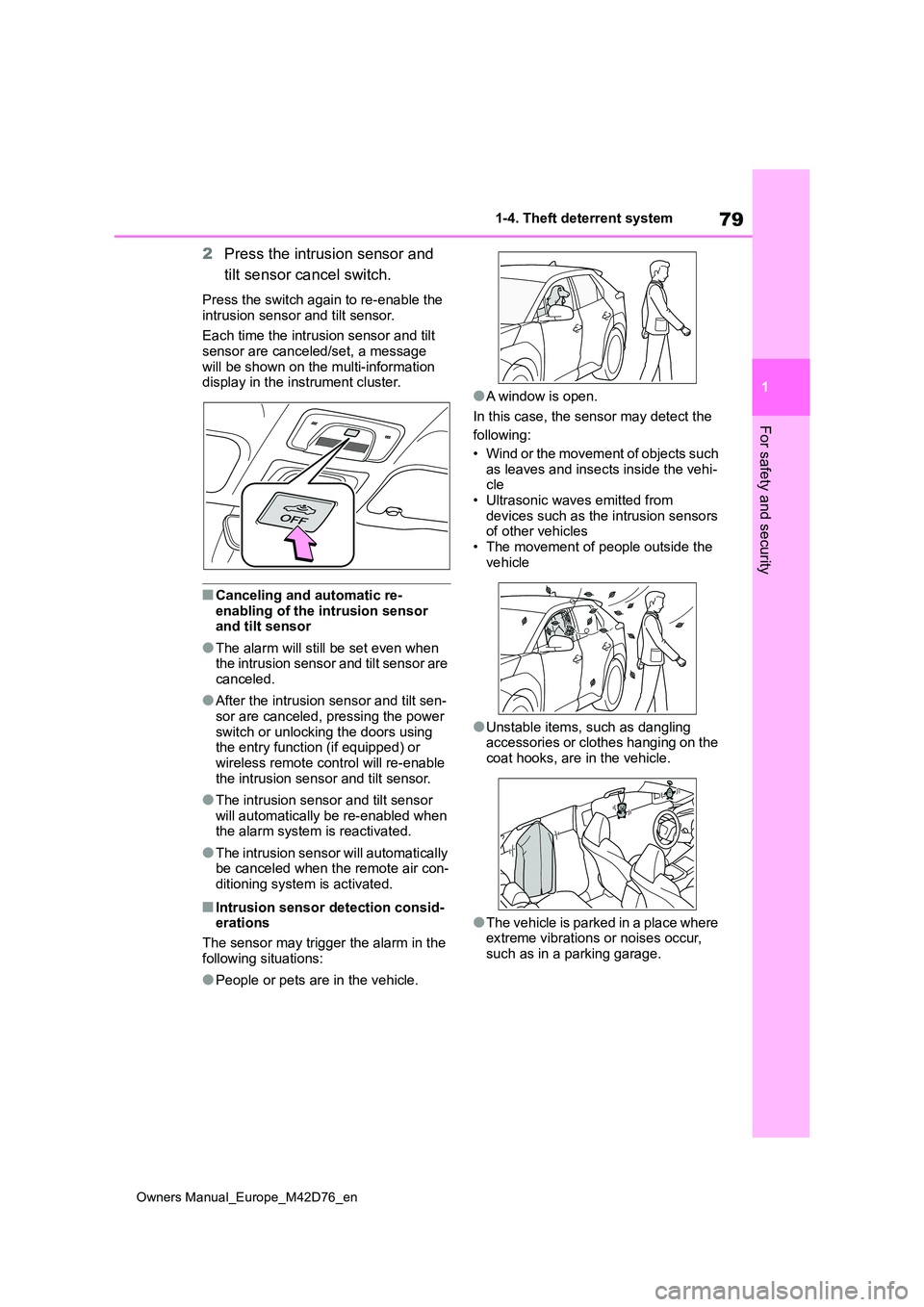
79
1
Owners Manual_Europe_M42D76_en
1-4. Theft deterrent system
For safety and security
2Press the intrusion sensor and
tilt sensor cancel switch.
Press the switch again to re-enable the
intrusion sensor and tilt sensor.
Each time the intrusion sensor and tilt sensor are canceled/set, a message
will be shown on the multi-information display in the instrument cluster.
■Canceling and automatic re-
enabling of the intrusion sensor and tilt sensor
●The alarm will still be set even when the intrusion sensor and tilt sensor are canceled.
●After the intrusion sensor and tilt sen-sor are canceled, pressing the power
switch or unlocking the doors using the entry function (if equipped) or wireless remote control will re-enable
the intrusion sensor and tilt sensor.
●The intrusion sensor and tilt sensor
will automatically be re-enabled when the alarm system is reactivated.
●The intrusion sensor will automatically be canceled when the remote air con-ditioning system is activated.
■Intrusion sensor detection consid-erations
The sensor may trigger the alarm in the
following situations:
●People or pets are in the vehicle.
●A window is open.
In this case, the sensor may detect the
following:
• Wind or the movement of objects such as leaves and insects inside the vehi-cle
• Ultrasonic waves emitted from devices such as the intrusion sensors of other vehicles
• The movement of people outside the vehicle
●Unstable items, such as dangling accessories or clothes hanging on the coat hooks, are in the vehicle.
●The vehicle is parked in a place where extreme vibrations or noises occur,
such as in a parking garage.
Page 82 of 674
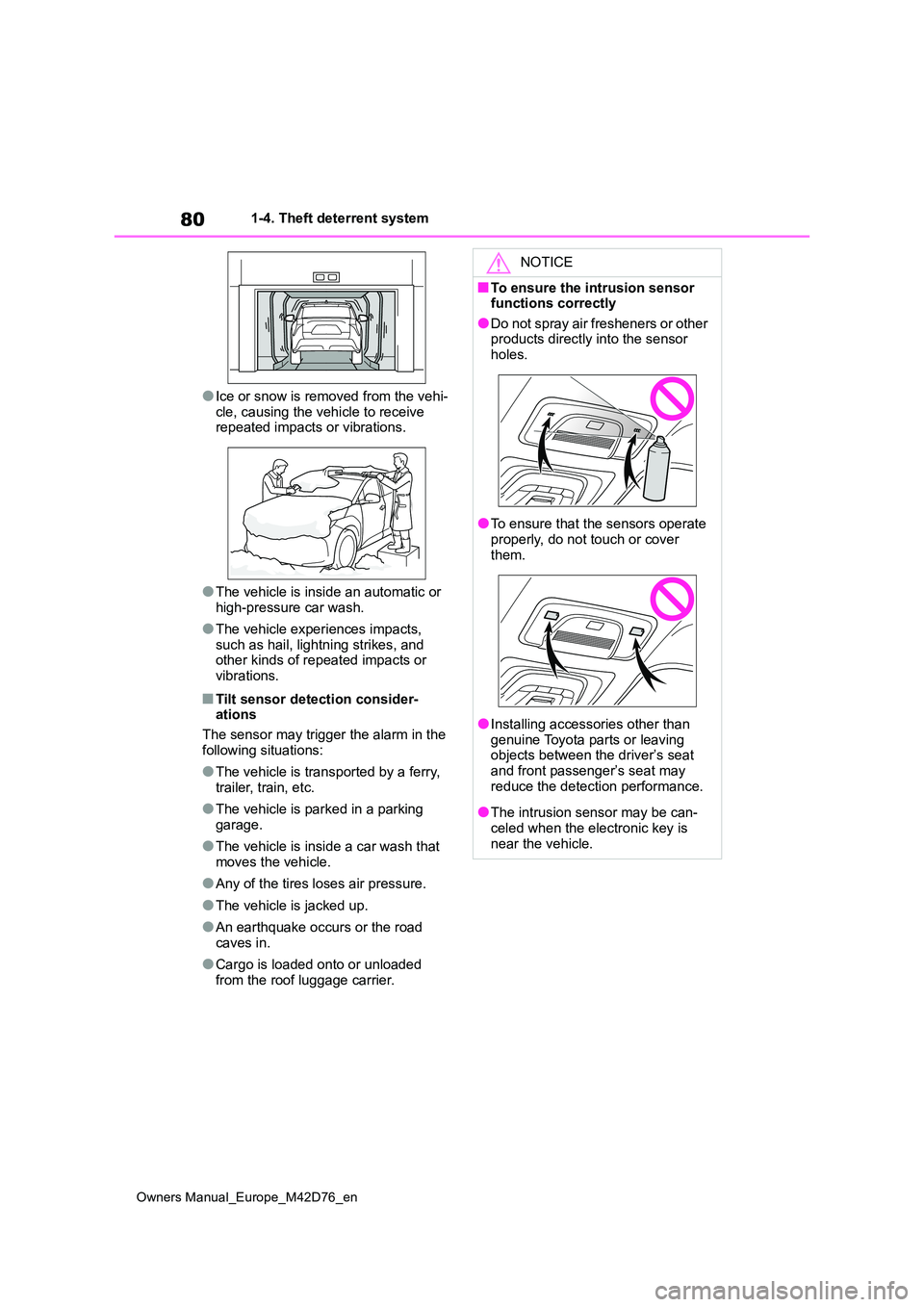
80
Owners Manual_Europe_M42D76_en
1-4. Theft deterrent system
●Ice or snow is removed from the vehi-
cle, causing the vehicle to receive repeated impacts or vibrations.
●The vehicle is inside an automatic or high-pressure car wash.
●The vehicle experiences impacts, such as hail, lightning strikes, and other kinds of repeated impacts or
vibrations.
■Tilt sensor detection consider- ations
The sensor may trigger the alarm in the
following situations:
●The vehicle is transported by a ferry,
trailer, train, etc.
●The vehicle is parked in a parking
garage.
●The vehicle is inside a car wash that
moves the vehicle.
●Any of the tires loses air pressure.
●The vehicle is jacked up.
●An earthquake occurs or the road caves in.
●Cargo is loaded onto or unloaded from the roof luggage carrier.
NOTICE
■To ensure the intrusion sensor functions correctly
●Do not spray air fresheners or other products directly into the sensor holes.
●To ensure that the sensors operate properly, do not touch or cover
them.
●Installing accessories other than
genuine Toyota parts or leaving objects between the driver’s seat and front passenger’s seat may
reduce the detection performance.
●The intrusion sensor may be can-
celed when the electronic key is near the vehicle.
Page 83 of 674
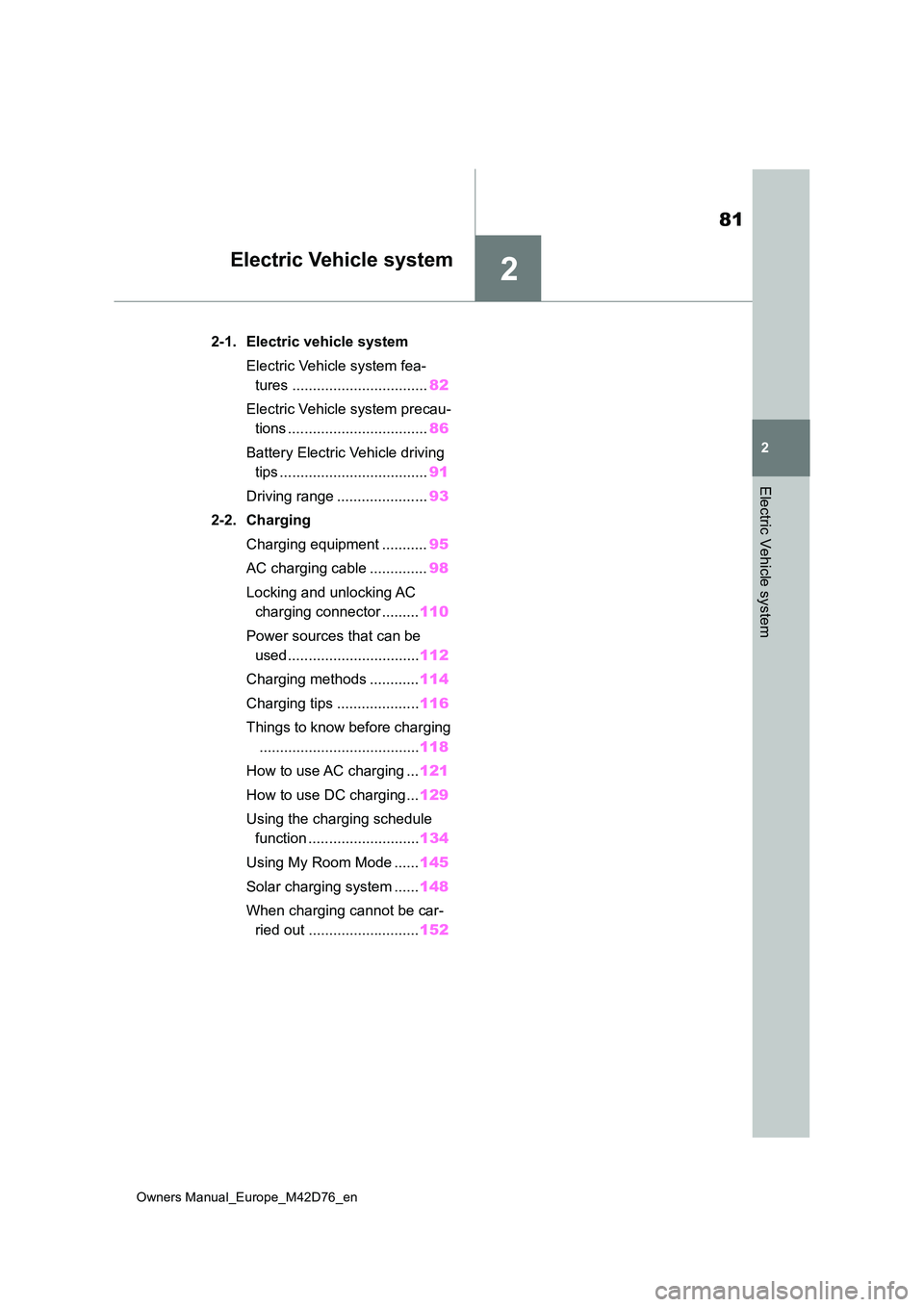
2
81
Owners Manual_Europe_M42D76_en
2
Electric Vehicle system
Electric Vehicle system
2-1. Electric vehicle system
Electric Vehicle system fea-
tures ................................. 82
Electric Vehicle system precau-
tions .................................. 86
Battery Electric Vehicle driving
tips .................................... 91
Driving range ...................... 93
2-2. Charging
Charging equipment ........... 95
AC charging cable .............. 98
Locking and unlocking AC
charging connector ......... 110
Power sources that can be
used ................................ 112
Charging methods ............ 114
Charging tips .................... 116
Things to know before charging
....................................... 118
How to use AC charging ... 121
How to use DC charging ... 129
Using the charging schedule
function ........................... 134
Using My Room Mode ...... 145
Solar charging system ...... 148
When charging cannot be car-
ried out ........................... 152
Page 84 of 674
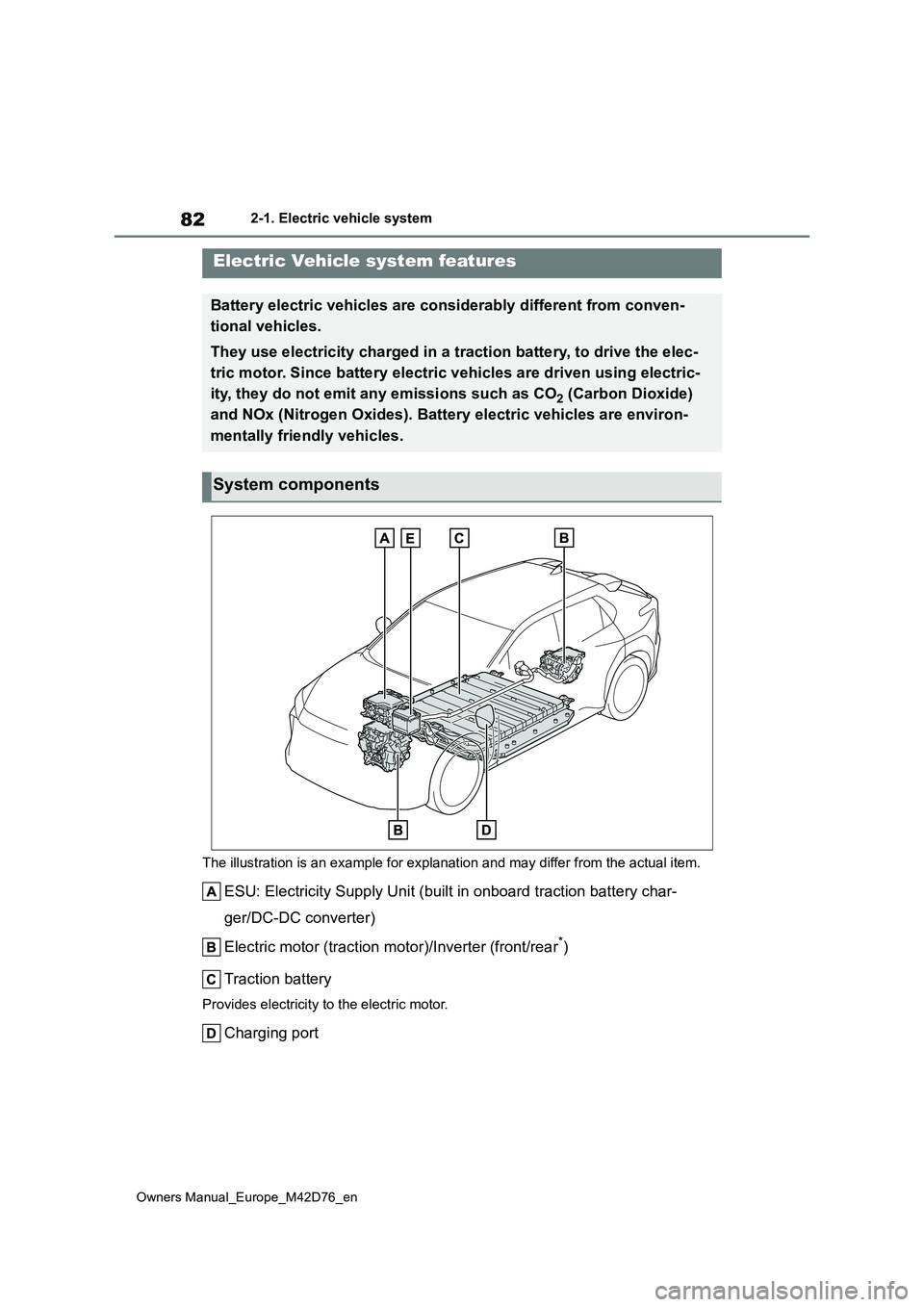
82
Owners Manual_Europe_M42D76_en
2-1. Electric vehicle system
2-1.Electric vehicle sys tem
The illustration is an example for explanation and may differ from the actual item.
ESU: Electricity Supply Unit (built in onboard traction battery char-
ger/DC-DC converter)
Electric motor (traction mo tor)/Inverter (front/rear*)
Traction battery
Provides electricity to the electric motor.
Charging port
Electric Vehicle system features
Battery electric vehicles are cons iderably different from conven-
tional vehicles.
They use electricity charged in a traction battery, to drive th e elec-
tric motor. Since battery electric vehicles are driven using el ectric-
ity, they do not emit any emissions such as CO2 (Carbon Dioxide)
and NOx (Nitrogen Oxides). Battery electric vehicles are enviro n-
mentally friendly vehicles.
System components
Page 85 of 674
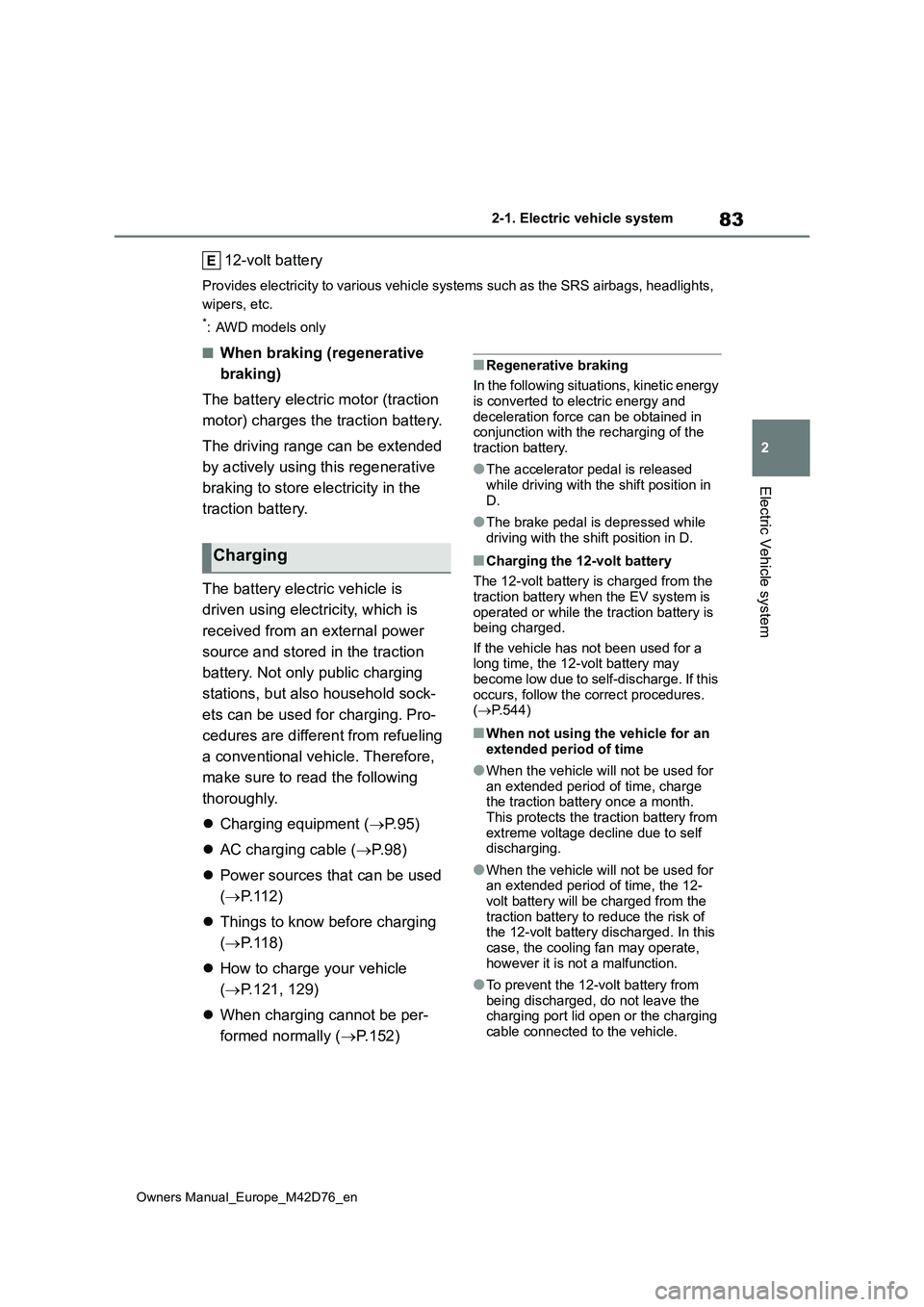
83
2
Owners Manual_Europe_M42D76_en
2-1. Electric vehicle system
Electric Vehicle system
12-volt battery
Provides electricity to various vehicle systems such as the SRS airbags, headlights,
wipers, etc.
*: AWD models only
■When braking (regenerative
braking)
The battery electric motor (traction
motor) charges the traction battery.
The driving range can be extended
by actively using this regenerative
braking to store electricity in the
traction battery.
The battery electric vehicle is
driven using electricity, which is
received from an external power
source and stored in the traction
battery. Not only public charging
stations, but also household sock-
ets can be used for charging. Pro-
cedures are different from refueling
a conventional vehicle. Therefore,
make sure to read the following
thoroughly.
Charging equipment (P.95)
AC charging cable (P. 9 8 )
Power sources that can be used
( P.112)
Things to know before charging
( P.118)
How to charge your vehicle
( P.121, 129)
When charging cannot be per-
formed normally ( P.152)
■Regenerative braking
In the following situations, kinetic energy
is converted to electric energy and deceleration force can be obtained in conjunction with the recharging of the
traction battery.
●The accelerator pedal is released
while driving with the shift position in D.
●The brake pedal is depressed while driving with the shift position in D.
■Charging the 12-volt battery
The 12-volt battery is charged from the
traction battery when the EV system is operated or while the traction battery is being charged.
If the vehicle has not been used for a long time, the 12-volt battery may become low due to self-discharge. If this
occurs, follow the correct procedures. ( P.544)
■When not using the vehicle for an
extended period of time
●When the vehicle will not be used for
an extended period of time, charge the traction battery once a month. This protects the traction battery from
extreme voltage decline due to self discharging.
●When the vehicle will not be used for an extended period of time, the 12-volt battery will be charged from the
traction battery to reduce the risk of the 12-volt battery discharged. In this case, the cooling fan may operate,
however it is not a malfunction.
●To prevent the 12-volt battery from
being discharged, do not leave the charging port lid open or the charging cable connected to the vehicle.
Charging
Page 86 of 674
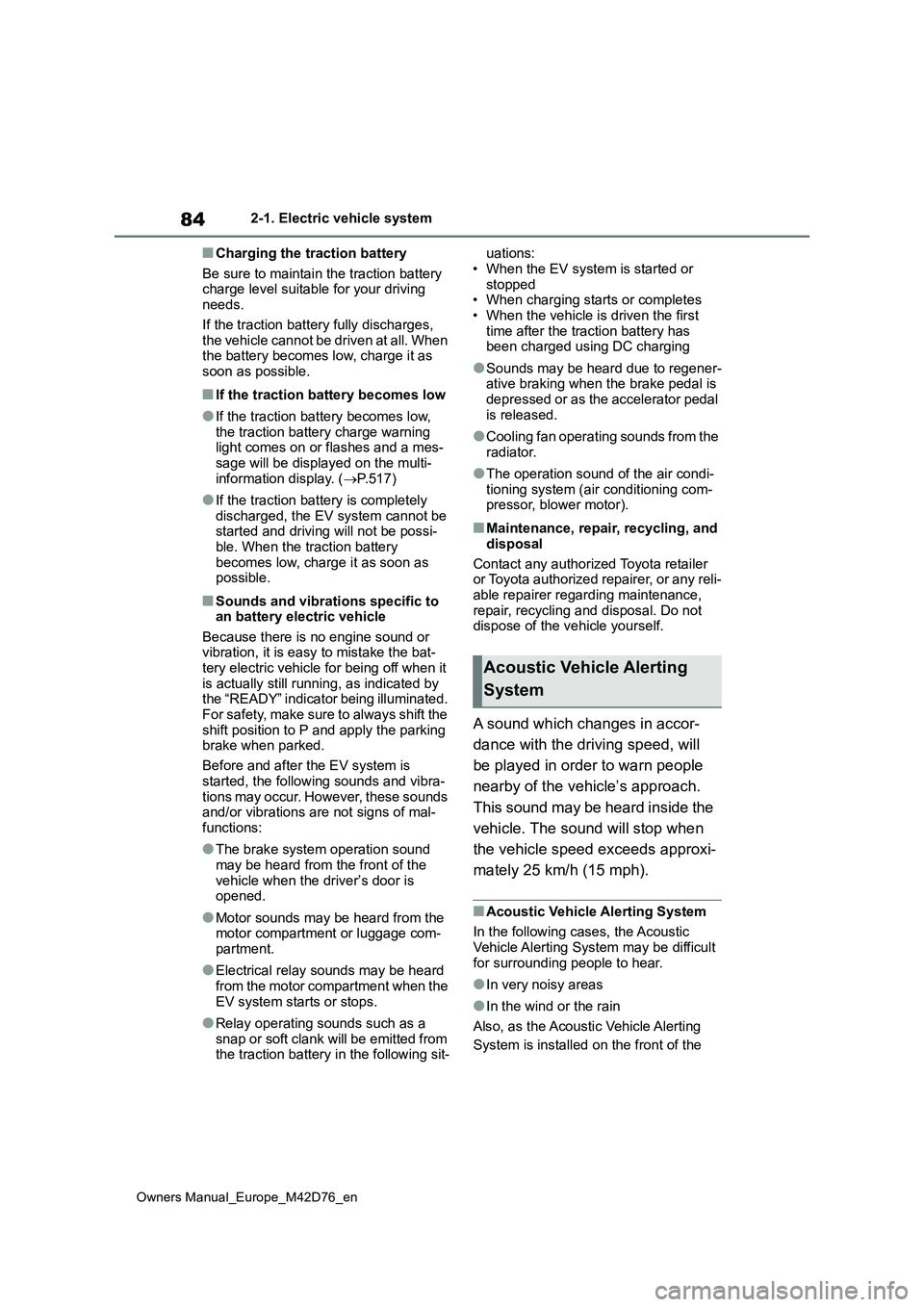
84
Owners Manual_Europe_M42D76_en
2-1. Electric vehicle system
■Charging the traction battery
Be sure to maintain the traction battery charge level suitable for your driving needs.
If the traction battery fully discharges, the vehicle cannot be driven at all. When the battery becomes low, charge it as
soon as possible.
■If the traction battery becomes low
●If the traction battery becomes low,
the traction battery charge warning light comes on or flashes and a mes-sage will be displayed on the multi-
information display. ( P.517)
●If the traction battery is completely
discharged, the EV system cannot be started and driving will not be possi-ble. When the traction battery
becomes low, charge it as soon as possible.
■Sounds and vibrations specific to an battery electric vehicle
Because there is no engine sound or vibration, it is easy to mistake the bat-tery electric vehicle for being off when it
is actually still running, as indicated by the “READY” indicator being illuminated. For safety, make sure to always shift the
shift position to P and apply the parking brake when parked.
Before and after the EV system is
started, the following sounds and vibra- tions may occur. However, these sounds and/or vibrations are not signs of mal-
functions:
●The brake system operation sound
may be heard from the front of the vehicle when the driver’s door is opened.
●Motor sounds may be heard from the motor compartment or luggage com-
partment.
●Electrical relay sounds may be heard
from the motor compartment when the EV system starts or stops.
●Relay operating sounds such as a snap or soft clank will be emitted from the traction battery in the following sit-
uations:
• When the EV system is started or stopped• When charging starts or completes
• When the vehicle is driven the first time after the traction battery has been charged using DC charging
●Sounds may be heard due to regener-ative braking when the brake pedal is
depressed or as the accelerator pedal is released.
●Cooling fan operating sounds from the radiator.
●The operation sound of the air condi-tioning system (air conditioning com-pressor, blower motor).
■Maintenance, repair, recycling, and
disposal
Contact any authorized Toyota retailer or Toyota authorized repairer, or any reli-
able repairer regarding maintenance, repair, recycling and disposal. Do not dispose of the vehicle yourself.
A sound which changes in accor-
dance with the driving speed, will
be played in order to warn people
nearby of the vehicle’s approach.
This sound may be heard inside the
vehicle. The sound will stop when
the vehicle speed exceeds approxi-
mately 25 km/h (15 mph).
■Acoustic Vehicle Alerting System
In the following cases, the Acoustic Vehicle Alerting System may be difficult
for surrounding people to hear.
●In very noisy areas
●In the wind or the rain
Also, as the Acoustic Vehicle Alerting
System is installed on the front of the
Acoustic Vehicle Alerting
System
Page 87 of 674
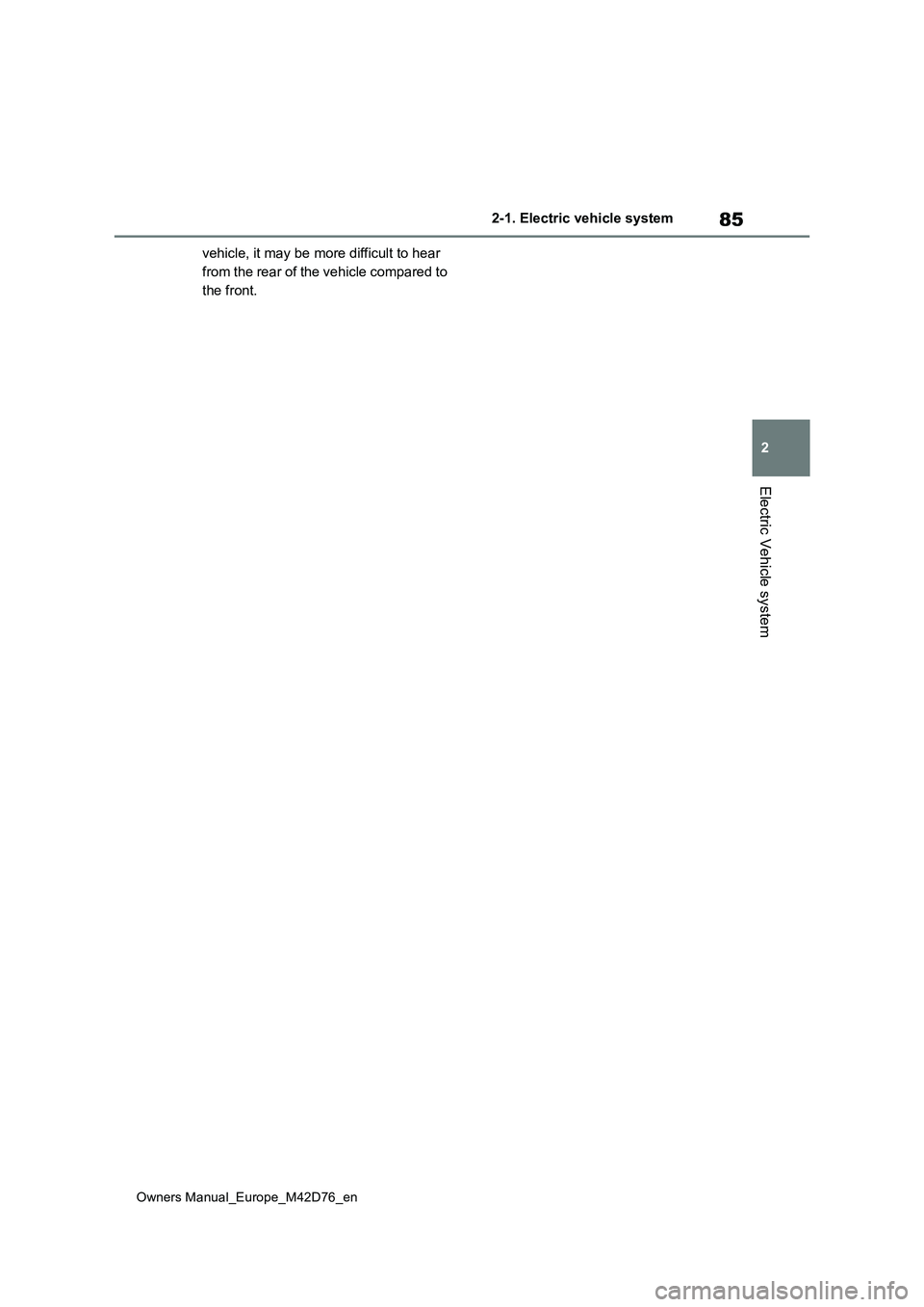
85
2
Owners Manual_Europe_M42D76_en
2-1. Electric vehicle system
Electric Vehicle system
vehicle, it may be more difficult to hear
from the rear of the vehicle compared to
the front.
Page 88 of 674
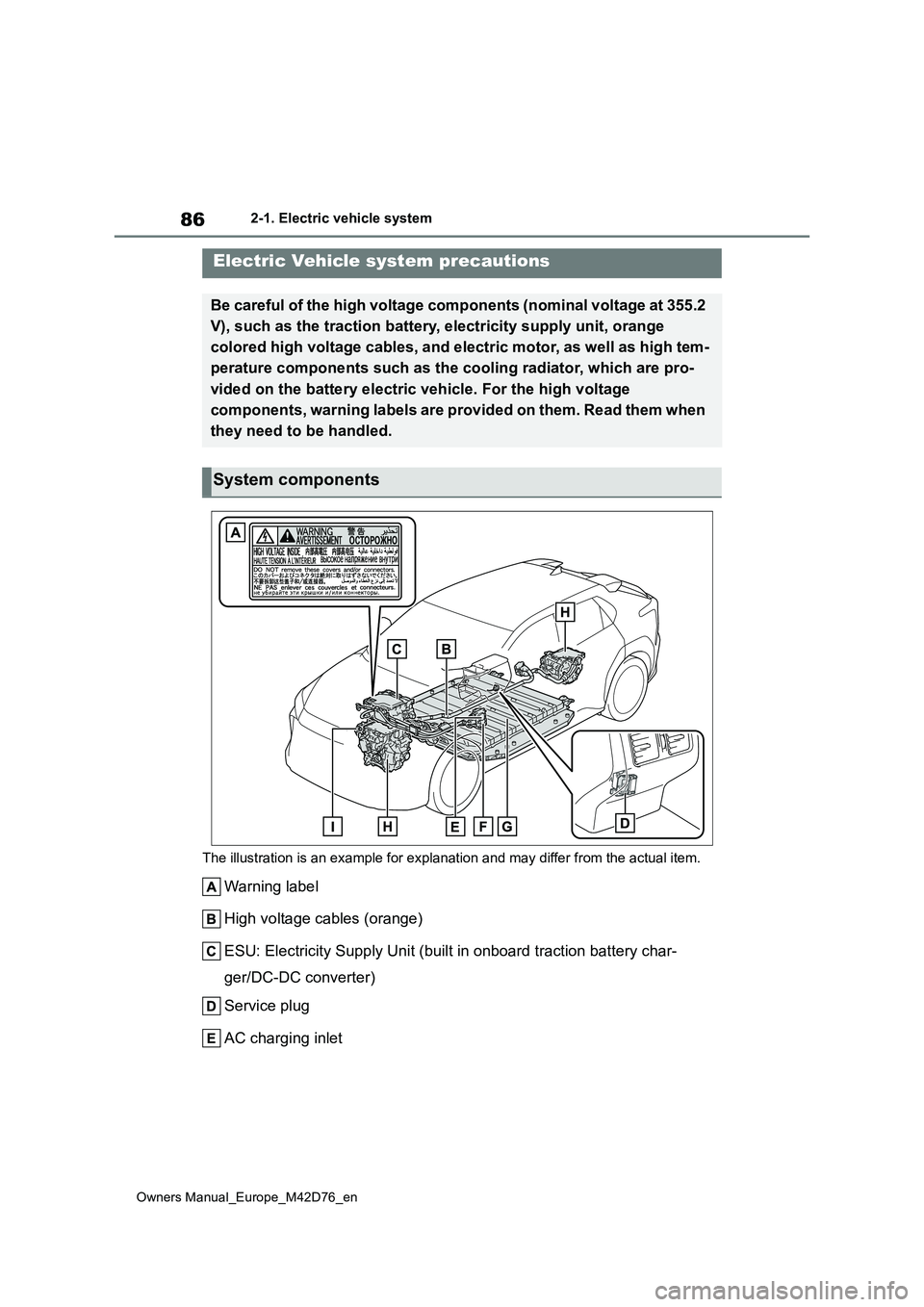
86
Owners Manual_Europe_M42D76_en
2-1. Electric vehicle system
The illustration is an example for explanation and may differ f rom the actual item.
Warning label
High voltage cables (orange)
ESU: Electricity Supply Unit (built in onboard traction battery char-
ger/DC-DC converter)
Service plug
AC charging inlet
Electric Vehicle system precautions
Be careful of the high voltage components (nominal voltage at 3 55.2
V), such as the traction battery , electricity supply unit, orange
colored high voltage cables, and electric motor, as well as hig h tem-
perature components such as the cooling radiator, which are pro -
vided on the battery electric vehicle. For the high voltage
components, warning labels are provided on them. Read them when
they need to be handled.
System components
Page 89 of 674
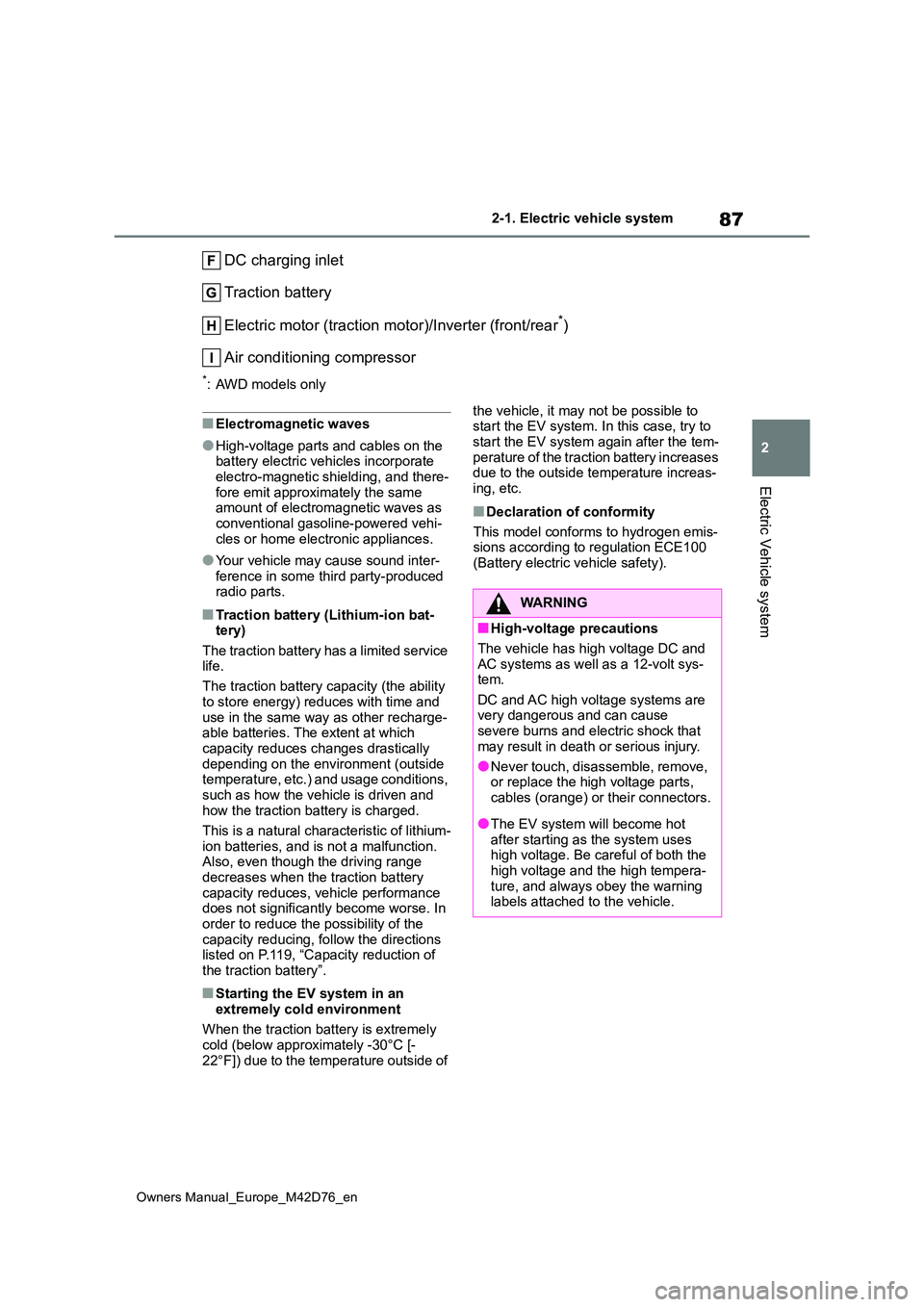
87
2
Owners Manual_Europe_M42D76_en
2-1. Electric vehicle system
Electric Vehicle system
DC charging inlet
Traction battery
Electric motor (traction mo tor)/Inverter (front/rear*)
Air conditioning compressor
*: AWD models only
■Electromagnetic waves
●High-voltage parts and cables on the battery electric vehicles incorporate electro-magnetic shielding, and there-
fore emit approximately the same amount of electromagnetic waves as conventional gasoline-powered vehi-
cles or home electronic appliances.
●Your vehicle may cause sound inter-
ference in some third party-produced radio parts.
■Traction battery (Lithium-ion bat-tery)
The traction battery has a limited service life.
The traction battery capacity (the ability
to store energy) reduces with time and use in the same way as other recharge-able batteries. The extent at which
capacity reduces changes drastically depending on the environment (outside temperature, etc.) and usage conditions,
such as how the vehicle is driven and how the traction battery is charged.
This is a natural characteristic of lithium-
ion batteries, and is not a malfunction. Also, even though the driving range decreases when the traction battery
capacity reduces, vehicle performance does not significantly become worse. In order to reduce the possibility of the
capacity reducing, follow the directions listed on P.119, “Capacity reduction of the traction battery”.
■Starting the EV system in an
extremely cold environment
When the traction battery is extremely cold (below approximately -30°C [-
22°F]) due to the temperature outside of
the vehicle, it may not be possible to start the EV system. In this case, try to
start the EV system again after the tem- perature of the traction battery increases due to the outside temperature increas-
ing, etc.
■Declaration of conformity
This model conforms to hydrogen emis- sions according to regulation ECE100
(Battery electric vehicle safety).
WARNING
■High-voltage precautions
The vehicle has high voltage DC and AC systems as well as a 12-volt sys-tem.
DC and AC high voltage systems are very dangerous and can cause severe burns and electric shock that
may result in death or serious injury.
●Never touch, disassemble, remove, or replace the high voltage parts,
cables (orange) or their connectors.
●The EV system will become hot
after starting as the system uses high voltage. Be careful of both the high voltage and the high tempera-
ture, and always obey the warning labels attached to the vehicle.
Page 90 of 674
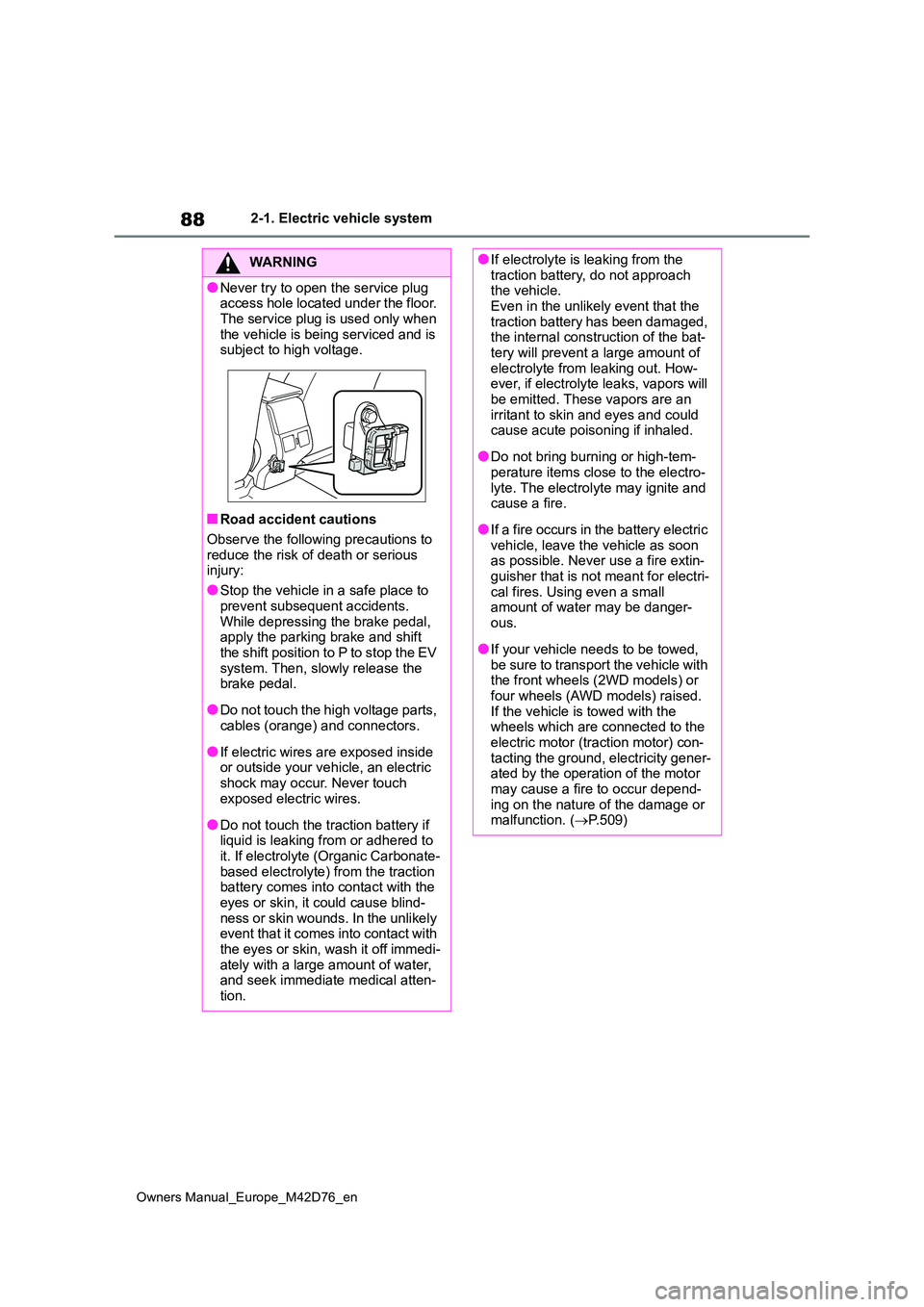
88
Owners Manual_Europe_M42D76_en
2-1. Electric vehicle system
WARNING
●Never try to open the service plug access hole located under the floor.
The service plug is used only when the vehicle is being serviced and is subject to high voltage.
■Road accident cautions
Observe the following precautions to
reduce the risk of death or serious injury:
●Stop the vehicle in a safe place to
prevent subsequent accidents. While depressing the brake pedal, apply the parking brake and shift
the shift position to P to stop the EV system. Then, slowly release the brake pedal.
●Do not touch the high voltage parts, cables (orange) and connectors.
●If electric wires are exposed inside or outside your vehicle, an electric
shock may occur. Never touch exposed electric wires.
●Do not touch the traction battery if liquid is leaking from or adhered to it. If electrolyte (Organic Carbonate-
based electrolyte) from the traction battery comes into contact with the eyes or skin, it could cause blind-
ness or skin wounds. In the unlikely event that it comes into contact with the eyes or skin, wash it off immedi-
ately with a large amount of water, and seek immediate medical atten-tion.
●If electrolyte is leaking from the traction battery, do not approach the vehicle.
Even in the unlikely event that the traction battery has been damaged, the internal construction of the bat-
tery will prevent a large amount of electrolyte from leaking out. How-ever, if electrolyte leaks, vapors will
be emitted. These vapors are an irritant to skin and eyes and could cause acute poisoning if inhaled.
●Do not bring burning or high-tem-perature items close to the electro-
lyte. The electrolyte may ignite and cause a fire.
●If a fire occurs in the battery electric vehicle, leave the vehicle as soon as possible. Never use a fire extin-
guisher that is not meant for electri- cal fires. Using even a small amount of water may be danger-
ous.
●If your vehicle needs to be towed,
be sure to transport the vehicle with the front wheels (2WD models) or four wheels (AWD models) raised.
If the vehicle is towed with the wheels which are connected to the electric motor (traction motor) con-
tacting the ground, electricity gener- ated by the operation of the motor may cause a fire to occur depend-
ing on the nature of the damage or malfunction. ( P.509)